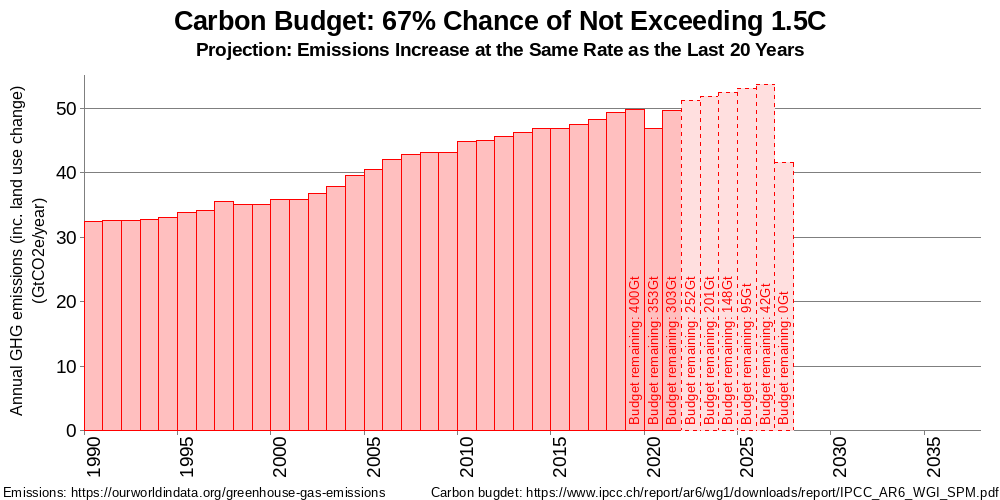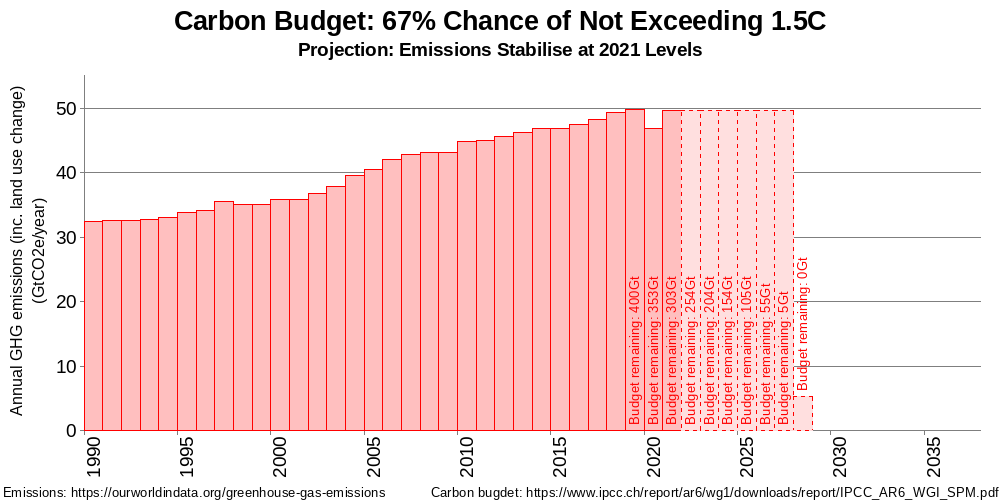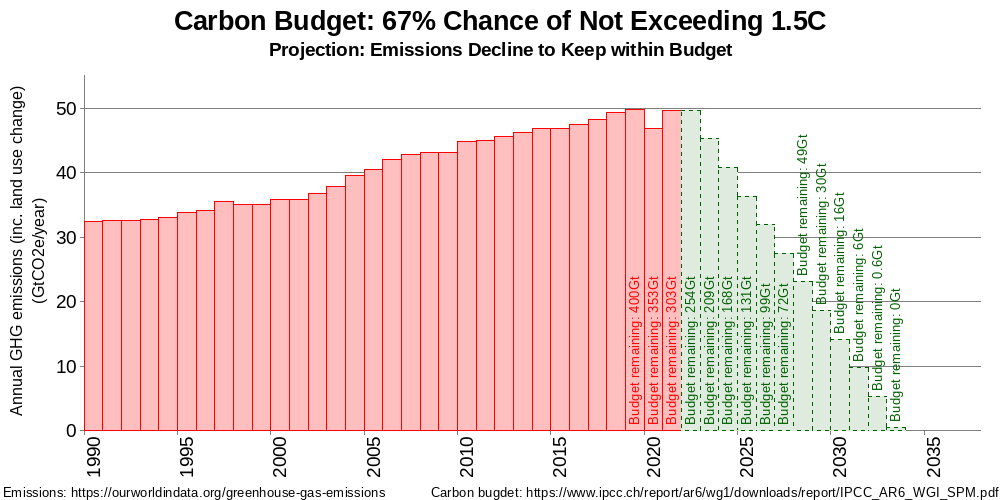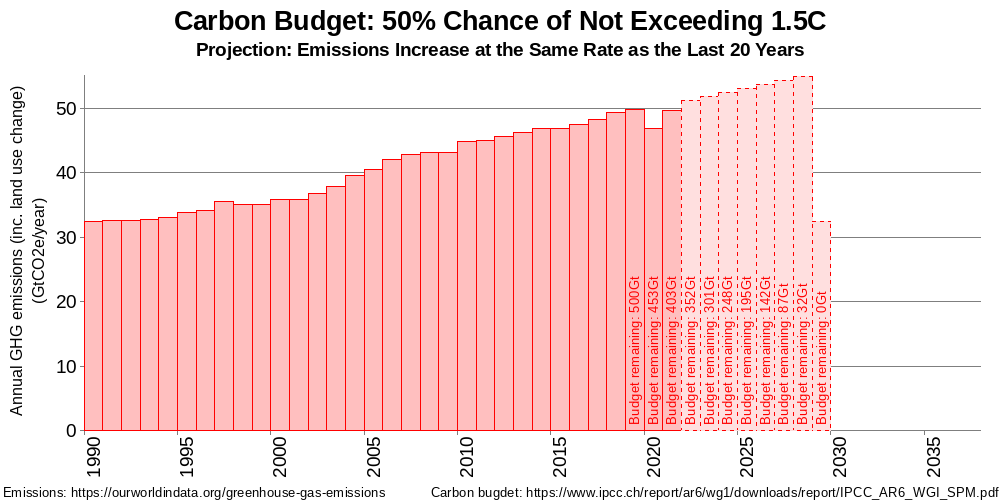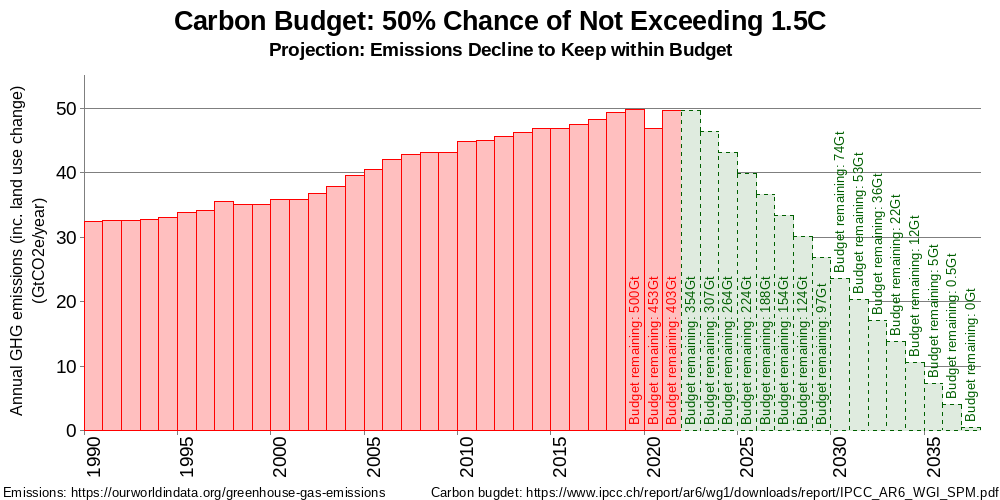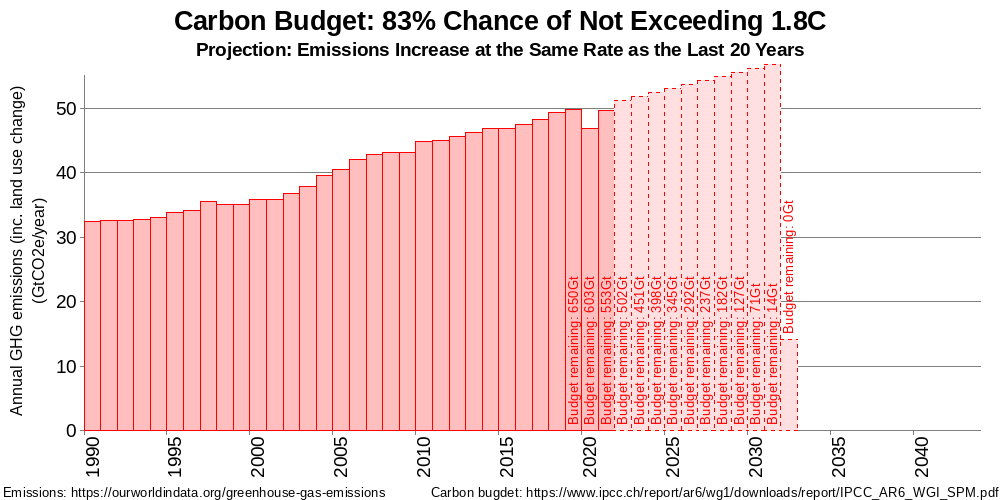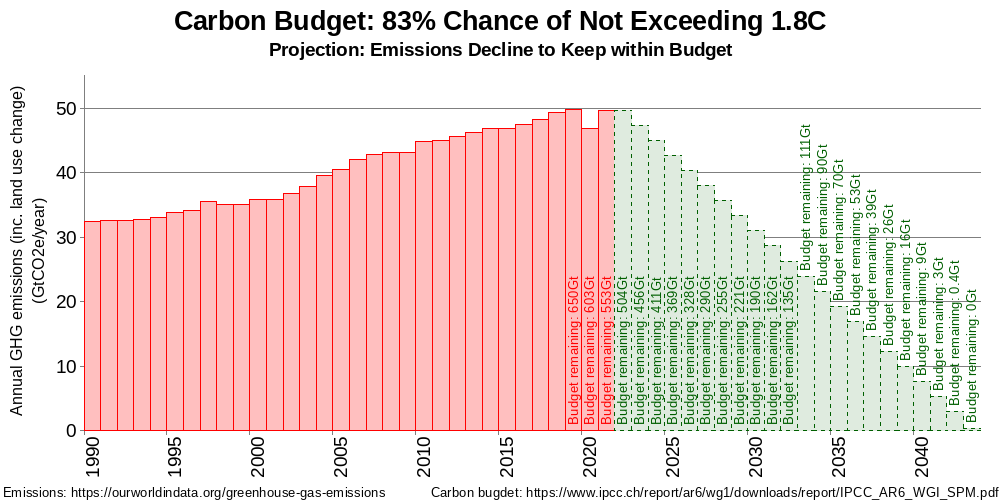How Much Carbon Budget Is Left?
I'd heard of the carbon budget and the need to halve emissions by 2030. It was only when I watched the Netflix documentary Breaking Boundaries: The Science of our Planet that I realised how truly urgent the situation is and how the carbon budget demands that we halve emissions by 2030.
At about 1h00min into Breaking Boundaries: The Science of our Planet David Attenborough tells us (as of May 2021) that:
"Since the beginning of the industrial revolution we have emitted 2,400 billion tonnes of carbon dioxide. To stay below 1.5° we must emit less than 300 billion tonnes more. If we continue to emit 40 billion tonnes each year our budget will run out within 7 years."
When I checked this claim, it stands up. See below.
What Is The Carbon Budget?
On p29 of its Assessment Report 6 Working Group 1 Summary For Policymakers the IPCC states:
"D.1.2 Over the period 1850-2019, a total of 2390 ± 240 (likely range) GtCO₂ of anthropogenic CO₂ was emitted. Remaining carbon budgets have been estimated for several global temperature limits and various levels of probability."
"Table SPM.2 | Estimates of historical carbon dioxide (CO₂) emissions and remaining carbon budgets" shows
- For a 50% chance of staying within 1.5°C the remaining budget is 500GtCO₂
- For a 67% chance of staying within 1.5°C it's 400GtCO₂
- For an 83% chance of staying within 1.5°C it's 300GtCO₂
The table footnotes include: "This likelihood is based on the uncertainty in transient climate response to cumulative CO₂ emissions (TCRE) and additional Earth system feedbacks and provides the probability that global warming will not exceed the temperature levels provided".
David Attenborough has quoted the budget for an 83% chance of staying within 1.5°C. And who wouldn't want a high chance of not exceeding 1.5°C! a scenario which the UK government's Net Zero Strategy (p14) describes thus:
"Above 1.5°C we risk reaching climatic tipping points like the melting of arctic permafrost - releasing millennia of stored greenhouse gases - meaning we could lose control of our climate for good."
How Many Years Of Carbon Budget Are Left?
Given the IPCC's budgets, we need to know the amount of climate-warming gases emitted each year. This data is available from https://ourworldindata.org/greenhouse-gas-emissions (Oxford University) in the chart "Global greenhouse gas emissions".
If you download this data, plot it on a graph and extrapolate the rising trend into the future, you see that the carbon budget for a 67% chance of staying within 1.5°C runs out in 2027:
Notes
- I've allowed a lower (67%) chance of not exceeding 1.5°C than David Attenborough.
- The data from Ourworldindata.org runs only to 2019; I've extrapolated the years 2020 and 2021 assuming the emissions follow the same trend as the chart "CO₂ emissions from energy combustion and industrial processes, 1900-2021" in the IEA report Global Energy Review: CO₂ Emissions in 2021.
- The Ourworldindata.org chart notes "Greenhouse gas emissions are measured in carbon dioxide-equivalents (CO₂eq)." ie it includes warming caused by methane, nitrous oxide, etc.
- It also notes "Emissions from land use change - which can be positive or negative - are taken into account." - this means the emissions from eg deforestation, draining peat-lands, ploughing unploughed land; minus the CO₂ absorbed by eg reforesting.
- Is the Ourworldindata.org data correct? The numbers in the World Bank's report Total greenhouse gas emissions (kt of CO₂ equivalent) are about 3Gt lower.
- The UN Environment Programme's Emissions Gap Report 2021 "Figure ES.1. Global greenhouse gas emissions from all sources, 1970-2020" (p5) shows numbers about 10Gt higher.
What If We Could Stabilise Emissions?
Suppose we could stabilise emissions at 2021 levels. The carbon budget for a 67% chance of staying within 1.5°C runs out in 2028:
How Long Have We Got If We Cut Emissions?
Suppose we cut emissions at a steady rate beginning in 2023. For a 67% chance of staying within 1.5°C, we need to halve them by 2028 in order to eke out the budget to 2033:
It's worth noting that:
In order to meet the Paris Treaty objective to prevent global warming passing 1.5°C, the future emissions trajectories of all countries need to look similar to above, no matter how much they have already cut their emissions.
What If We Risked A 50% Chance Of Staying Within 1.5°C?
Given the dire situation portrayed in the charts above for a 67% chance of staying within 1.5°C, how much more time would we have if we accepted a 50% chance of staying within 1.5°C?
If you extrapolate the growing trend into the future, you see that the carbon budget for a 50% chance of staying within 1.5°C runs out in 2029:
Suppose we cut emissions at a steady rate beginning in 2023. For a 50% chance of staying within 1.5°C, we need to halve them by 2030 in order to eke out the budget to 2037:
Really? Is That All The Time We Have Left?
Maybe the worst consequences of climate change won't kick in if we can hold temperatures below 2°C. In "Table SPM.2 | Estimates of historical carbon dioxide (CO₂) emissions and remaining carbon budgets" on p29 of the IPCC's Assessment Report 6 Working Group 1 Summary For Policymakers the highest probability estimated of staying within 2°C is 83%. But I'd like a 100% percent chance of staying within 2°C. Wouldn't you?
I followed the suggestion beneath that table and found on p98 of the IPCC's Assessment Report 6 Working Group 1 Technical Summary that
- For a 83% chance of staying within 1.8°C the remaining budget is 650GtCO₂
If you extrapolate the growing trend into the future, you see that the carbon budget for a 83% chance of staying within 1.8°C runs out in 2032:
And if we cut emissions at a steady rate beginning in 2023, for a 83% chance of staying within 1.8°C, we need to halve them by 2033 in order to eke out the budget to 2043:
Whichever scenario we consider, it is clear that we truly face a climate emergency and that massive change is required urgently.
Good luck, everyone!
Back to Arctic Death Spiral | About | Sitemap
Twitter: @ArcticDthSpiral | Instagram: @ArcticDeathSpiral
